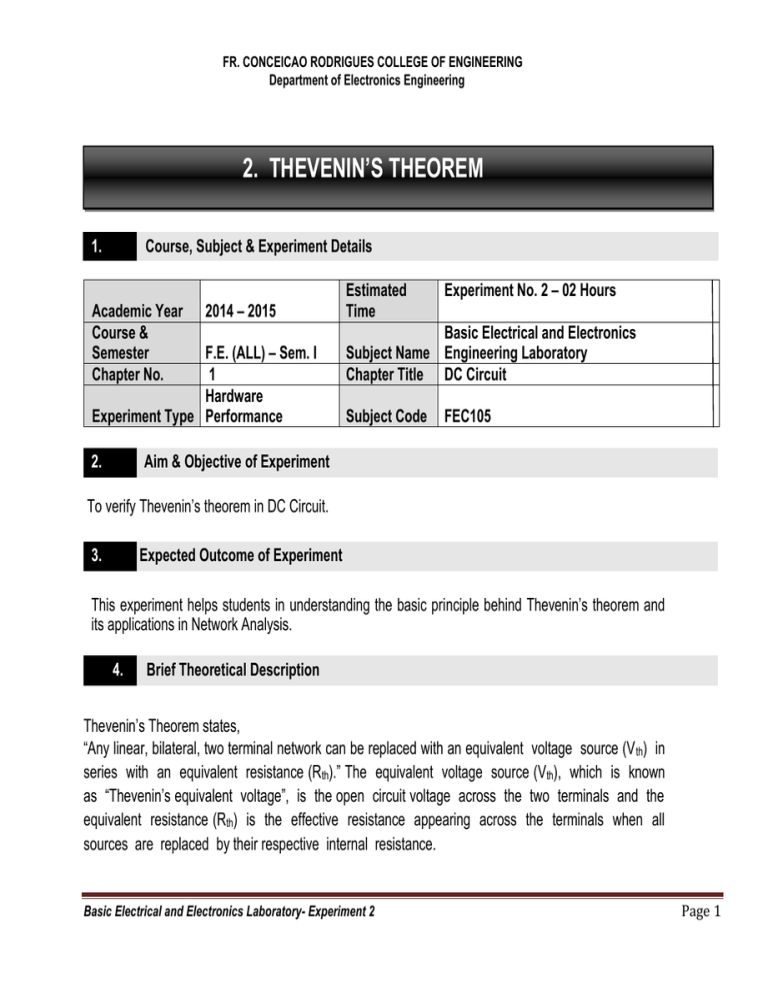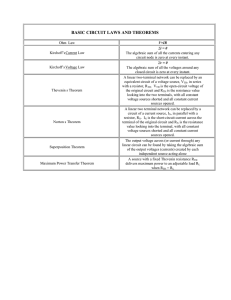2. THEVENIN`S THEOREM
advertisement

FR. CONCEICAO RODRIGUES COLLEGE OF ENGINEERING Department of Electronics Engineering 2. THEVENIN’S THEOREM 1. Course, Subject & Experiment Details Academic Year Course & Semester Chapter No. 2014 – 2015 F.E. (ALL) – Sem. I 1 Hardware Experiment Type Performance 2. Estimated Time Experiment No. 2 – 02 Hours Basic Electrical and Electronics Subject Name Engineering Laboratory Chapter Title DC Circuit Subject Code FEC105 Aim & Objective of Experiment To verify Thevenin’s theorem in DC Circuit. 3. Expected Outcome of Experiment This experiment helps students in understanding the basic principle behind Thevenin’s theorem and its applications in Network Analysis. 4. Brief Theoretical Description Thevenin’s Theorem states, “Any linear, bilateral, two terminal network can be replaced with an equivalent voltage source (V th) in series with an equivalent resistance (Rth).” The equivalent voltage source (Vth), which is known as “Thevenin’s equivalent voltage”, is the open circuit voltage across the two terminals and the equivalent resistance (Rth) is the effective resistance appearing across the terminals when all sources are replaced by their respective internal resistance. Basic Electrical and Electronics Laboratory- Experiment 2 Page 1 FR. CONCEICAO RODRIGUES COLLEGE OF ENGINEERING Department of Electronics Engineering The theorem can be experimentally verified by measuring the current through load resistance (at least three different values) in the given circuit and then the current through the same load resistance in the Thevenin’s circuit. Same value of currents observed through particular load resistance in both the circuits proves the equivalence of the two circuits. 5. Circuit Diagram & Experimental Setup 100Ω 100Ω RTH RL 10 V RL Vth 100Ω + _ + _ IL fig.2 fig.3 Fig 1 6. IL Fig 2 Apparatus and components required 1. Breadboard 2. Power supply 3. Multimeter 4. Connecting wires. 5. 0 - 10 V DC 1 No. Resistances Basic Electrical and Electronics Laboratory- Experiment 2 Page 2 FR. CONCEICAO RODRIGUES COLLEGE OF ENGINEERING Department of Electronics Engineering 7. Experimental Procedure 1. 2. 3. 4. Connect the circuit as shown in fig.1. For different values of RL, note the current through it. Remove RL and note voltage across the two terminals (Vth) Replace the voltage source by a short circuit and measure the resistance between the terminals. (Rth) 5. Connect a voltage source of value Vth in series with a resistance Rth (TEC) 6. Connect the load resistance across the circuit and for different values of RL, note the current through it. 7. Verify with the actual values. 8. 88 Observation Table Thevenin’s Equivalent voltage (Vth) = Thevenin’s Equivalent resistance (Rth) = Load Current Load Resistance RL (Ω) Actual Circuit IL (mA) Thevenin’s Equivalent IL (mA) Theoretical ckt. IL (mA) 100 150 220 Basic Electrical and Electronics Laboratory- Experiment 2 Page 3 FR. CONCEICAO RODRIGUES COLLEGE OF ENGINEERING Department of Electronics Engineering 9. Conclusions & Inferences . 10. Post Lab Questions 1. Calculate the current in load resistance for the above circuit by applying Thevenin’s theorem. 2. Explain Max power transfer Theorem. In the above circuit find the max power that can be transferred to the load resistance. * * Basic Electrical and Electronics Laboratory- Experiment 2 * * * Page 4




